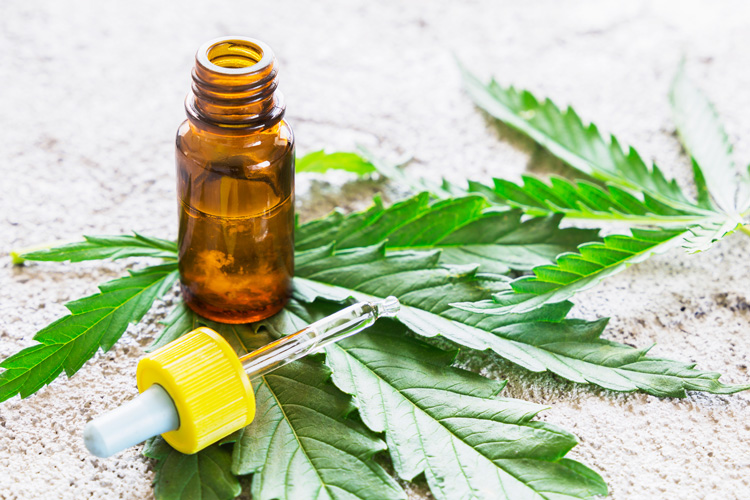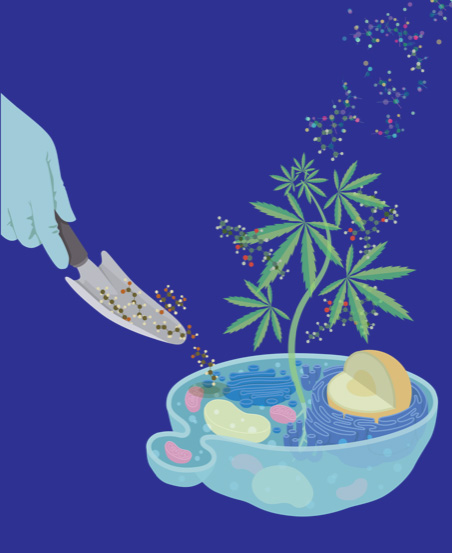Yeast produce low-cost, high-quality cannabinoids
Scientists alter yeast metabolism to produce THC, CBD and other cannabis derivatives
February 27, 2019

UC Berkeley researchers have found a way to make the main chemicals in marijuana, THC and CBD, from yeast. (iStock photo)
UC Berkeley synthetic biologists have engineered brewer’s yeast to produce marijuana’s main ingredients—mind-altering THC and non-psychoactive CBD—as well as novel cannabinoids not found in the plant itself.
Feeding only on sugar, the yeast are an easy and cheap way to produce pure cannabinoids that today are costly to extract from the buds of the marijuana plant, Cannabis sativa.
“For the consumer, the benefits are high-quality, low-cost CBD and THC: you get exactly what you want from yeast,” said Jay Keasling, a UC Berkeley professor of chemical and biomolecular engineering and of bioengineering and a faculty scientist at Lawrence Berkeley National Laboratory. “It is a safer, more environmentally friendly way to produce cannabinoids.”
Cannabis and its extracts, including the high-inducing THC, or tetrahydrocannabinol, are now legal in 10 states and the District of Columbia, and recreational marijuana—smoked, vaped or consumed as edibles—is a multibillion-dollar business nationwide. Medications containing THC have been approved by the Food and Drug Administration to reduce nausea after chemotherapy and to improve appetite in AIDS patients.
CBD, or cannabidiol, is used increasingly in cosmetics—so-called cosmeceuticals—and has been approved as a treatment for childhood epileptic seizures. It is being investigated as a therapy for numerous conditions, including anxiety, Parkinson’s disease and chronic pain.
But medical research on the more than 100 other chemicals in marijuana has been difficult, because the chemicals occur in tiny quantities, making them hard to extract from the plant. Inexpensive, purer sources—like yeast—could make such studies easier.
Plus, he added, there is “the possibility of new therapies based on novel cannabinoids: the rare ones that are nearly impossible to get from the plant, or the unnatural ones, which are impossible to get from the plant.”
Keasling, the Philomathia Foundation Chair in Alternative Energy at Berkeley, and his colleagues will report their results online Feb. 27 in advance of publication in the journal Nature.
Plugging chemical pathways into yeast
Cannabinoids join many other chemicals and drugs now being produced in yeast, including human growth hormone, insulin, blood clotting factors and recently, but not yet on the market, morphine and other opiates.

Researchers feed sugar to genetically engineered yeast and get out THC, CBD and other cannabinoids normally produced only by marijuana plants. (Graphic by Amy Cao)
One of the pioneers of synthetic biology, Keasling has long sought to exploit yeast and bacteria as “green” drug factories, eliminating the expensive synthetic or extractive processes common in the chemical industry and the often toxic or environmentally- damaging chemical byproducts.
Cannabis cultivation is a prime example of an energy-intensive and environmentally-destructive industry. Farms in northwest California have polluted streams with pesticide and fertilizer runoff and helped drain watersheds because marijuana plants are water-hungry. Illegal grows have resulted in clear-cutting and erosion.
Indoor cultivation under grow lights with ventilation fans uses a lot of energy, accounting for a growing percentage of annual power consumption. One study estimated that California’s cannabis industry accounted for 3 percent of the state’s electricity usage. Indoor grows have caused blackouts in some cities, and energy consumption can add more than $1,000 to the price of a pound of weed.
Hence Keasling’s interest in finding a “green” way to produce the active chemicals in marijuana.
“It was an interesting scientific challenge,” he admitted, that was akin to other challenges he and his team have successfully overcome in yeast: producing an antimalarial drug, artemisinin; turning plant waste into biofuels; synthesizing flavors and scents for the food and cosmetics industries and chemical intermediates for making new materials. “But when you read about cases of patients who have seizures and are helped by CBD, especially children, you realize there is some value in these molecules, and that producing cannabinoids in yeast could really be great.”
With approval and oversight by the U.S. Drug Enforcement Administration —cannabis is still illegal under federal law—Berkeley postdoc Xiaozhou Luo and visiting graduate student Michael Reiter, who led the project, started assembling in yeast a series of chemical steps to produce, initially, the mother of all cannabinoids, CBGA (cannabigerolic acid). In both marijuana and yeast, the chemical reactions involve the acid form of the compounds: CBGA and its derivatives, THCA and CBDA. They readily convert to CBG, THC and CBD when exposed to light and heat.
Turning yeast into chemical factories involves co-opting their metabolism so that, instead of turning sugar into alcohol, for example, yeast convert sugar into other chemicals that are then modified by added enzymes to produce a new product, such as THC, that the yeast secrete into the liquid surrounding them. The researchers ended up inserting more than a dozen genes into yeast, many of them copies of genes used by the marijuana plant to synthesize cannabinoids.
One step, however, proved to be a roadblock for Keasling’s group and competing groups: an enzyme that performs a key chemical step in making CBGA in the marijuana plant didn’t work in yeast.

To produce cannabinoids in yeast, Berkeley synthetic biologists first engineered yeast’s native mevalonate pathway to provide a high flux of geranyl pyrophosphate (GPP) and introduced a hexanoyl-CoA biosynthetic pathway combining genes from five different bacteria. They then introduced Cannabis genes encoding the enzymes involved in olivetolic acid (OA) biosynthesis, a previously undiscovered prenyl transferase enzyme and cannabinoid synthases. The synthases converted cannabigerolic acid (CBGA) to the cannabinoid acids THCA and CBDA, which, upon exposure to heat, decarboxylate to tetrahydrocannabinol (THC) and cannabidiol (CBD), respectively.
Rather than engineer a different synthetic pathway, Berkeley postdoc Leo d’Espaux and graduate student Jeff Wong went back to the plant itself and isolated a second enzyme, prenyl transferase, that does the same thing, and stuck it in the yeast.
“It worked like gangbusters,” Keasling said.
Once they had yeast-producing CBGA, they added another enzyme to convert CBGA to THCA and a different enzyme to create a pathway to CBDA. Though the products the yeast produce are predominantly THC or CBD, Keasling said, each must still be separated from other chemicals present in tiny quantities.
They also added enzymes that made the yeast produce two other natural cannabinoids, CBDV (cannabidivarin) and THCV (tetrahydrocannabivarin), whose effects are not well understood.
Surprisingly, Xiaozhou and Michael discovered that the enzymatic steps involved in making CBGA in yeast are flexible enough to accept a variety of starter chemicals—different fatty acids in place of the one used by the marijuana plant, hexanoic acid—that generate cannabinoids that do not exist in the plant itself. They also got the yeast to incorporate chemicals into cannabinoids that could later be chemically altered in the lab, creating another avenue for producing never-before-seen, but potentially medically useful, cannabinoids.
Keasling subsequently founded an Emeryville, California, company, Demetrix Inc., which d’Espaux and Wong later joined, that licensed the technology from Berkeley to use yeast fermentation to make cannabinoids.
“The economics look really good,” Keasling said. “The cost is competitive or better than that for the plant-derived cannabinoids. And manufacturers don’t have to worry about contamination—for example, THC in CBD—that would make you high.”
The work was supported by the National Science Foundation (1330914). Other co-authors of the paper are Charles Denby, Anna Lechner, Yunfeng Zhang, Adrian Grzybowski and Kai Deng of UC Berkeley and Simon Harth, Weiyin Lin, Hyunsu Lee, Changhua Yu, John Shin, Veronica Benites, George Wang, Edward Baidoo, Yan Chen, Ishaan Dev and Christopher Petzold of Berkeley Lab.